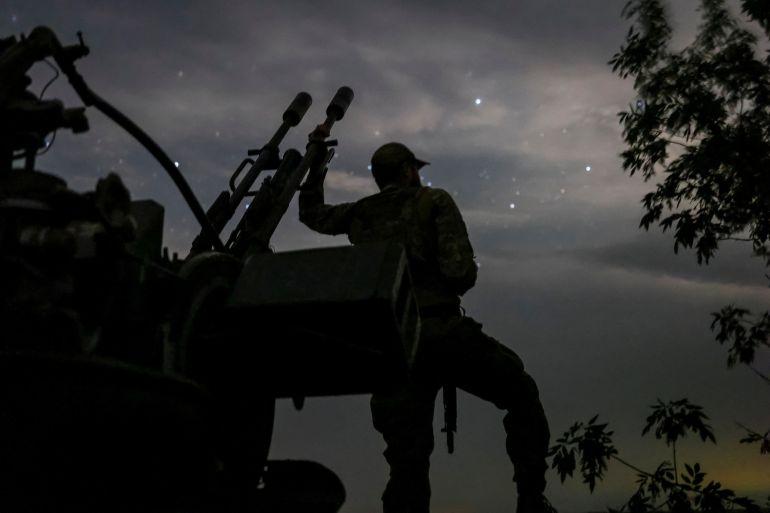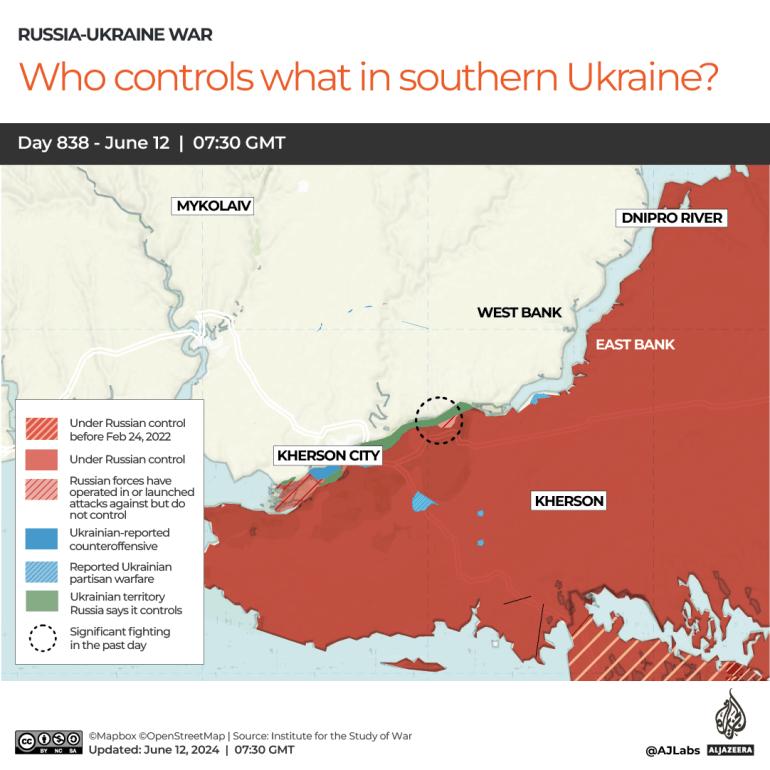Source: ALJAZEERA
ALJAZEERA MEDIA NETWORK

Observers suggest that for Ukraine to secure victory, it must have unrestricted access to strike Russian territory.
Russia has not achieved any notable victories in its conflict with Ukraine over the past week and has faced several challenges on its own ground, in occupied Crimea, and in occupied Georgia.
Simultaneously, Russia made attempts to demonstrate its power beyond its borders by dispatching a fleet to Cuba, which conducted missile drills en route and threatened to supply long-range weapons to Western enemies.
On the ground, Russia's incursion into the northern Kharkiv region of Ukraine seems to have halted, as forces leading two separate missions in Vovchansk and north of Lyptsi made no progress.
Ukrainian military representatives have characterized the May 10 incursion as an attempt to divert their troops from safeguarding Chasiv Yar, an essential position in Donetsk on the eastern front. Here, Russian forces made steady but small advances throughout the past week. However, the Khortytsia Group defending this area said that Russian forces were not inside Chasiv Yar.

Visual evidence indicated Russian forces remained 700-800 meters east of the Siverskyi Donets-Donbas Canal, which runs along the eastern border of Chasiv Yar.
An attempted incursion north of Sumy on June 9 progressed about 700m into Ukraine but seemed ineffective as it failed to establish a meaningful presence, reported the Institute for the Study of War, a think tank based in Washington.
Ukraine's military administration in Sumy ordered the evacuation of eight villages within 10km (6.2 miles) of the Russian border.
![A Ukrainian serviceman of the 33rd Separate Mechanised Brigade smokes during a break as he attends a military drill near a front line in the Donetsk region [Alina Smutko/Reuters]](https://nowtrends.net/storage/2024/06/2LMNEYOO1PJA_T3E0YNOO189L.jpg) A Ukrainian serviceman of the 33rd Separate Mechanised Brigade smokes during a break as he attends a military drill near a front line in the Donetsk region [Alina Smutko/Reuters]
A Ukrainian serviceman of the 33rd Separate Mechanised Brigade smokes during a break as he attends a military drill near a front line in the Donetsk region [Alina Smutko/Reuters]
A recent change in allied policy towards Ukrainian arms use has complicated Russian logistics over the past week.
In late May, the United States and Germany joined France and the United Kingdom in permitting Ukraine to use their weapons within Russia, in response to the Kharkiv offensive.
On Monday, the Ukrainian partisan group Atesh, which operates in occupied Crimea, reported that Russian officials started moving air defense systems to the Russian border region of Belgorod, "which poses a security threat in Crimea, leaving it unprotected".
Ukraine used US-made Army Tactical Missiles (ATACMs) to further dismantle Crimea’s air defenses on that day. Its general staff reported destroying the main radar of an S-400 air defense battery in Dzhankoi, and the radars of S-300 batteries in Yevpatoria and Chernomorsk, all in northern and western occupied Crimea. Without radar, the associated missile launchers can't function.

Crimean air defense serves as a shield for the Russian region of Krasnodar Krai and the Russian naval port of Novorossiysk just to its east, which was considered safe after multiple Ukrainian attacks on the port of Sevastopol in Crimea.
However, in early June, the Russian Black Sea Fleet moved about 18 ships out of Novorossiysk. Ukrainian navy spokesman Dmytro Pletenchuk said Russians realized their ships were vulnerable.
On Saturday, the Ukrainian Navy reported that seven of these Russian vessels were relocated to the Sea of Azov, likely to protect the Kerch Bridge, which links Krasnodar Krai to Crimea.
Russia used the bridge on June 8 to ferry fuel to Crimea, something it had avoided since March, preferring a ferry crossing next to the bridge instead. Ukraine used US weapons to target the Russian side of the Kerch ferry crossing on May 31, complicating Russian logistics as geographic restrictions were lifted.
The bridge's vulnerability has been known since October 2022, when Ukraine first struck it with a truck bomb, and it proved vulnerable to Ukrainian naval drones last July. Recently, Russia has placed barges on either side of the bridge for additional protection from naval drones.

While the UK and France have not publicly restricted the use of their weapons anywhere on Russian soil, the US and Germany have permitted their use only in response to incoming fire and only in Kharkiv.
The ISW critiqued this policy, stating it "removed a maximum of 16 percent of Russia's ground sanctuary" compared to a broader range of territories in Belgorod, Kursk, and Bryansk regions that could be targeted using US-made High Mobility Army Rocket systems (HIMARS), and called for the administration to give Ukraine free rein.
Russian President Vladimir Putin stated at the Saint Petersburg International Economic Forum that supplying Western adversaries with long-range weapons would be a "symmetrical response" to lifting Ukraine's restriction from striking Russian soil with allied weapons. He also threatened to use nuclear arms.
Besides lifting geographic restrictions, Ukraine is expected to receive F-16 fighter jets this year.
One report indicated it could obtain 60 decommissioned jets from Denmark, Norway, and the Netherlands. Ukraine, still using Soviet aircraft, mentioned it needs twice that number to defend its airspace. On June 6, French President Emmanuel Macron announced France would send French Mirage 2000-5 fighters to Ukraine without specifying the quantity or timing.
Ukraine seemed less than enthused.
"Like all modern aircraft, the Mirage 2000 can effectively perform assigned combat missions. It can carry out both air and ground strikes. The aircraft is quite modern, but the F-16 remains a priority," said Ukrainian Air Force spokesman Ilya Yevlash the next day.
During interviews with French television networks on the eve of celebrations marking the 80th anniversary of the Normandy landings that ended World War II, Macron also stated France would train a battalion of Ukrainian troops (4,500) on French soil.
 (Al Jazeera)
(Al Jazeera)
Ukraine has the freedom to use its homemade weapons and continued to target military and energy facilities in Russia, a tactic it has employed since early this year.
Ukrainian drones hit refineries in Belgorod and Rostov on June 6. Two days later, its drones attacked Russia's Mozdok military base in North Ossetia, a Georgian territory occupied by Russia since August 2008. Ukraine also struck a Russian command post in Belgorod on June 9 with an unspecified weapon.
The most notable attack took place on June 8.
Ukraine's military intelligence (GUR) claimed to have damaged a Russian Sukhoi-57 multirole fighter. It released satellite images appearing to show the plane surrounded by scorch marks on the tarmac at Akhtubinsk airfield in Astrakhan region, 589km (366 miles) from the front line.

The Su-57 is Russia's most advanced combat aircraft, and this attack would mark the first damage to this aircraft in the Ukraine conflict.
"Images dated 8 June reveal craters from the explosion and distinct fire marks caused by the strike," said GUR. It reported that Russia has around six Su-57s in active service, with another six under production. "Data continue to be refined. Preliminary information indicates there could be two Su-57 aircraft affected," said a GUR representative the next day on a telethon. "There is also information about irretrievable losses and injuries among the occupying personnel."
Ukraine claimed the planes had been used to launch Kh-59 and Kh-69 missiles into its territory.
Russia continued targeting Ukraine's energy infrastructure. On Friday, Ukraine's air force reported it shot down 48 out of 53 Shahed drones launched by Russia, targeting Ukrainian energy facilities. It also downed five X-101/X-555 missiles.
Russia has used drone and missile combinations to severely damage Ukraine's power infrastructure during the past winter.
Ukrainian Prime Minister Denys Shmyhal stated on Friday that Russia had damaged or destroyed 73 percent of the country's power plants. The Financial Times noted that Russia reduced Ukraine's pre-war electricity generation capacity of 55GW to only 20GW.
Russia also faced energy issues – not just from the refineries Ukraine has been targeting, reportedly reducing refining capacity by at least 14 percent.
A Stockholm arbitration court on Wednesday ruled that Germany’s main gas importer could demand significant damages from Russia for undelivered gas. The company, Uniper, was in a legal dispute with Russia's state gas supplier Gazprom over who was responsible for the non-delivery of gas through the Nordstream 2 pipeline, which was to have begun functioning in 2022 before it was sabotaged by unknown individuals.
The court concluded that Uniper might cancel its long-term contracts with Gazprom and seek 13 billion euros ($14bn) in damages from the Russian company.
Gazprom has faced other challenges lately. The Financial Times reported that Putin and Chinese leader Xi Jinping disagreed recently on a sale price for Russian gas to China, with Xi demanding prices near the subsidized domestic Russian rates. This impasse has delayed the Power of Siberia 2 pipeline, which Gazprom was supposed to start building to China.
Mainly due to the war in Ukraine and the loss of European sales, Gazprom posted a $6.9bn loss last year, its largest in 25 years. If the Power of Siberia 2 pipeline does not start operations in 2029, the Financial Times reported, Gazprom’s profits could drop by another 15 percent.

Your email address will not be published. Required fields are marked *